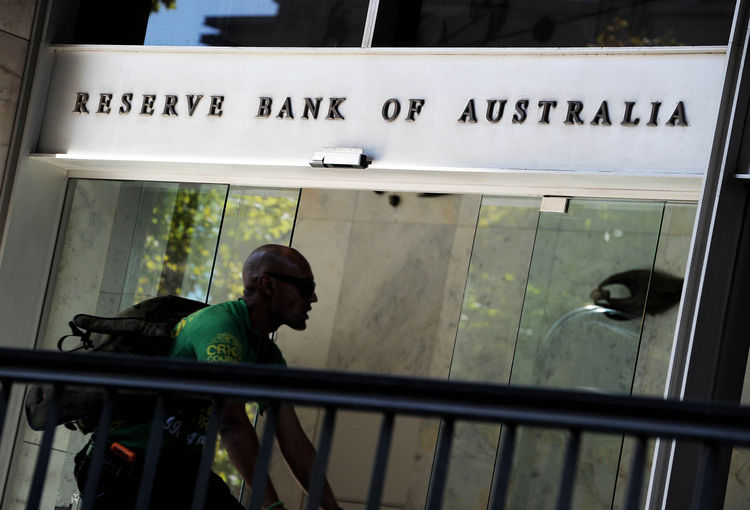- Australia Holds Rates as Inflation Speeds Up, Stimulus Signs Mount
Australia kept interest rates unchanged as faster inflation and signals of looming fiscal stimulus combine with an upswing in global growth.
“Above-trend growth is expected in a number of advanced economies,” Reserve Bank of Australia Governor Philip Lowe said in a statement announcing the decision Tuesday. “The improvement in the global economy has contributed to higher commodity prices, which are providing a significant boost to Australia’s national income.”
The central bank also left the cash rate at a record-low 1.5 percent — as expected by all 28 economists surveyed by Bloomberg — to allow regulatory rules targeting riskier property loans to take effect amid hot housing markets in Sydney and Melbourne.
The lending crackdown is designed to discourage households — already among the world’s most indebted — from gearing up further after east-coast property prices doubled since 2009. The RBA fears that, in a weak wage growth and with inflation still subdued, over-leveraged borrowers could slash spending in an economy where consumption accounts for more than half of output.
“Growth in housing debt has outpaced the slow growth in household incomes,” Lowe said. “The recently announced supervisory measures should help address the risks associated with high and rising levels of indebtedness.”
The Australian dollar edged higher, buying 75.42 U.S. cents as 3:18 p.m. in Sydney compared with 75.37 cents prior to the decision.
“The bank’s forecasts for the Australian economy are little changed. Growth is expected to increase gradually over the next couple of years to a little above 3 percent,” Lowe said in a preview of the central bank’s quarterly update due Friday. “Growth in consumption is expected to remain moderate and broadly in line with incomes. Non-mining investment remains low as a share of GDP and a stronger pick-up would be welcome.”
Australia’s government has given itself leeway to finance projects like road and rail by redefining debt in its May 9 budget. Treasurer Scott Morrison is seeking to distinguish between good debt — used for productivity enhancing or income-generating infrastructure — and bad debt used to fund things like welfare and health. That would ease the constant pressure on the RBA to support the economy since late 2011.
Low Wages
Stimulus is needed as wage growth remains at a record low, a product of the economy adjusting to regain competitiveness as the unwinding of a mining investment boom nears its completion. While inflation returned to the bottom end of the RBA’s 2 percent to 3 percent target in the first three months of the year after spending nine quarters below it, the key core measure didn’t.
Moreover, there’s little sign on the horizon of fatter pay packets to fuel consumer prices as the jobless rate holds at 5.9 percent and under-employment remains elevated, signaling plenty of slack in the labor market.
“The unemployment rate is expected to decline gradually over time,” said Lowe. “Wage growth remains slow and this is likely to remain the case for a while yet.”
Amazon Effect
The nation’s retailers have also been trapped in a deflationary environment as global brands entering the market drive down prices; they are likely to have to steel themselves anew following the announcement Amazon.com Inc. is heading Down Under.
On the upside, Australia is the most China-dependent economy in the developed world and is benefiting from demand in the world’s No. 2 economy for everything from commodities to education to tourism. Australia had a record 1.2 million visitors from China last year.
Business conditions have also remained strong, even as the Aussie dollar has risen more than 4 percent this year, one of the best performers in the Group of 10 currencies tracked by Bloomberg. That’s a headwind for services like tourism and education that must compete internationally.
The governor reiterated his long standard comment that an appreciating exchange rate “would complicate” the economy’s transition from a mining investment boom.
“Taking account of the available information, the board judged that holding the stance of monetary policy unchanged at this meeting would be consistent with sustainable growth in the economy and achieving the inflation target over time,” Lowe said in a concluding paragraph that was unchanged from last month.


 Forex2 weeks ago
Forex2 weeks ago


 Naira2 weeks ago
Naira2 weeks ago
 Naira4 weeks ago
Naira4 weeks ago
 Company News4 weeks ago
Company News4 weeks ago
 Billionaire Watch1 week ago
Billionaire Watch1 week ago




 Naira2 weeks ago
Naira2 weeks ago




 Naira4 weeks ago
Naira4 weeks ago




 Naira1 week ago
Naira1 week ago



















